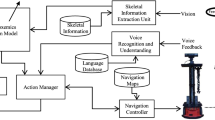Abstract
The robot called “Telepresence Robot” is on business in recent years. However, the robot does not consider user’s personal space when the robot approaches the user. Telepresence robot might give users fear if the robot unintentionally invades the user’s personal space when the user have conversation with the robot at the first time. To better develop the system of the robot, here we study about how near the robot approaches a user in advance. We verified the relationship between personal space and the big five by using neural network. It is revealed that the most influential factor for the neural network is agreeableness. By confirming user’s personal space in advance, the conversation between Telepresence Robot and human becomes natural and interactive.
Access this chapter
Tax calculation will be finalised at checkout
Purchases are for personal use only
Similar content being viewed by others
References
Nakanishi, H., Murakami, Y., Nogami, D., Ishiguro, H.: Minimum movement matters: impact of robot-mounted cameras on social telepresence. In: Proceedings of the 2008 ACM Conference on Computer Supported Cooperative Work. ACM (2008)
Kristoffersson, A., Coradeschi, S., Loutfi, A.: A review of mobile robotic telepresence. Adv. Hum. Comput. Interact. 2013, 3 (2013)
Nakauchi, Y., Simmons, R.: A social robot that stands in line. Auton. Robots 12(3), 313–324 (2002)
Bainbridge, W.A., Hart, J., Kim, E.S., Scassellati, B.: The effect of presence on human-robot interaction. In: The 17th IEEE International Symposium on Robot and Human Interactive Communication, RO-MAN 2008. IEEE (2008)
Walters, M.L., Dautenhahn, K., Te Boekhorst, R., Koay, K.L., Kaouri, C., Woods, S., Nehaniv, C., Lee, D., Werry, I.: The influence of subjects’ personality traits on personal spatial zones in a human-robot interaction experiment. In: IEEE International Workshop on Robot and Human Interactive Communication: ROMAN 2005. IEEE (2005)
Mumm, J., Mutlu, B.: Human-robot proxemics: physical and psychological distancing in human-robot interaction. In: Proceedings of the 6th International Conference on Human-Robot Interaction. ACM (2011)
Yasumoto, M., Kamide, H., Mae, Y., Ohara, K., Takubo, T., Arai, T.: Personal space for the humanoid robot and a presentation method. In: The Robotics and Mechatronics Conference, pp. 2A2-D18(1)–2A2-D18(4) (2010)
Kokubo, Y., Yamaguchi, Y., Sato-Shimokawara, E., Yamaguchi, T.: Influence of approaching patterns of telepresence robot for personal space. In: 2015 Conference on Technologies and Applications of Artificial Intelligence (TAAI 2015), Tayih Landis Hotel Tainan, Taiwan, 20–22 November 2015, pp. 221–226 (2015)
Mitsumura, S., Fujimoto, Y., Yamaguchi, T.: Development of a walking rehabilitation robot based on technique of physical therapist. In: 2014 RISP International Workshop on Nonlinear Circuits, Communications and Signal Processing NCSP 2014, Honolulu, Hawaii, USA, 28 February–3 March, pp. 629–632 (2014)
Yamaguchi, Y., Mitsumura, S., Kokubo, Y., Shimokawara, E., Yamaguchi, T.: Proposal of home-use telepresence robot system considering user’s personal space. In: 2015 RISP International Workshop on Nonlinear Circuits, Communications and Signal Processing (NCSP 2015), Kuala Lumpur, Malaysia, 28AM2-2-3, 27 February–2 March (2015)
Goldberg, L.R.: An alternative description of personality: the big-five factor structure. J. Pers. Soc. Psychol. 59(6), 1216 (1990)
Hall, M., et al.: The WEKA data mining software: an update. ACM SIGKDD Explor. Newsl. 11(1), 10–18 (2009)
Author information
Authors and Affiliations
Corresponding author
Editor information
Editors and Affiliations
Rights and permissions
Copyright information
© 2016 Springer International Publishing Switzerland
About this paper
Cite this paper
Kokubo, Y., Sato-Shimokawara, E., Yamaguchi, T. (2016). Relationship Between Personal Space and the Big Five with Telepresence Robot. In: Kubota, N., Kiguchi, K., Liu, H., Obo, T. (eds) Intelligent Robotics and Applications. ICIRA 2016. Lecture Notes in Computer Science(), vol 9835. Springer, Cham. https://doi.org/10.1007/978-3-319-43518-3_25
Download citation
DOI: https://doi.org/10.1007/978-3-319-43518-3_25
Published:
Publisher Name: Springer, Cham
Print ISBN: 978-3-319-43517-6
Online ISBN: 978-3-319-43518-3
eBook Packages: Computer ScienceComputer Science (R0)




